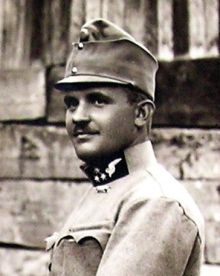|
Leopold Lojka
Leopold Lojka (also spelt Leopold Loyka) (17 September 1886 Telč, Moravia – 18 July 1926 Brno, Czechia) was the chauffeur of the car carrying Austro-Hungarian Archduke Franz Ferdinand at the time of Ferdinand's assassination in Sarajevo in 1914.[1] Early LifeLojka was born in 1886 to coach driver Václav Lojka and Marie, née Jašová. After graduating from general school in Telč, he trained as a butcher from 1907-1909.[2] Lojka joined the Austro-Hungarian army as a young man. During a maneuver in 1909, he distinguished himself when he recaptured some horses that had gone through in panic, for which he received a reward of 300 crowns. The Bohemian landowner and enthusiastic motorist Franz Graf Harrach, who witnessed this incident, then hired Lojka as his driver – impressed by his courage and efficiency and Lojka worked for Harrach from 1910-1914.[2] Sarajevo assassinationIn June 1914, Lojka accompanied his employer and his friend Archduke Franz Ferdinand, the heir to the throne of the Austro-Hungarian Dual Monarchy, on a trip to Bosnia and Herzegovina. There, on 26 and 27 June, the Archduke, in his capacity as "Inspector of the entire armed forces", took part as an observer in a manoeuvre of the Austro-Hungarian Army outside Sarajevo. A visit to the city itself was planned for June 28 at the end of the trip.  For this purpose, Harrach had provided the heir to the throne with his car, a double phaeton (28/32 hp) from Gräf & Stift, and driver. As a result, Lojka was given the task of picking up the Archduke and his companions at the Sarajevo train station on the morning of June 28 and driving them to the city center and all other destinations on the day's program.  In Franz Ferdinand's motorcade, which consisted of seven vehicles, the "heir to the throne" vehicle, with Lojka at the wheel, sitting on the front right (right-hand drive), drove in third place On the way from the train station to the town hall, there was a first assassination attempt: the young Nedeljko Čabrinović tried to throw a bomb on the car of the heir to the throne. This attempt failed – not least thanks to Lojka's presence of mind. After a stay in the town hall, the journey was resumed. In order to prevent further attacks, however, those responsible had decided to change the route: Instead of driving back only a little way along the Appelkai, over which they had come, as originally planned and announced in the newspapers, and then turning right into the city centre at Franz-Josef-Straße, they now wanted to forego turning and instead take the full route along the Appelkai on the banks of the Miljacka put back. Lojka, like the two drivers in front of him, who had not been informed of this, instead turned right at the corner of Appelkai-Franz-Josef-Straße, in accordance with the "old" route known to him. Oskar Potiorek, the head of Bosnia, who was the Archduke's host and was also in Lojka's car, then shouted to him to stop, as this was "the wrong way", and to turn around. When Lojka shifted into reverse gear in order to be able to reverse the vehicle, it stood still for a few seconds, which the young Bosnian Gavrilo Princip – like Čabrinović also a supporter of the nationalist movement Mlada Bosna – who was standing on the side of the road at the very spot where the vehicle came to a stop, used to fire two shots at the occupants at close range. These fatally injured Franz Ferdinand and his wife Sophie. After the assassination attempt – the fatal outcome of which was overlooked for a few seconds, as it was believed that the heir to the throne had only been slightly injured and his wife had fainted – Lojka turned the vehicle around on Potiorek's instructions and steered it to his official residence, the so-called Konak. Once there, the Archduke and his wife died within a few minutes. Immediately afterwards, Lojka sent three telegrams (to Emperor Franz Joseph, Emperor Wilhelm II and the Archduke's children) on behalf of the head of the country, Oskar Potiorek and/or Colonel Carl von Bardolff, informing the world about the assassination attempt and death of Franz Ferdinand. After the assassination On June 29, Lojka and Andreas Freiherr von Morsey identified Princip as the assassin in a confrontation ("It's him, the murderer"). He then appeared as a witness for the prosecution in the Sarajevo trial of the assassins and their accomplices. After the war, Lojka settled in Znojmo, where he ran an inn, which he sold in 1925. He then moved to Brno, where he opened a new inn, which he ran until his death in 1926. In addition, Lojka distinguished himself at this time through a series of interviews and reports in which he described the events of 28 June and thus became a world-famous figure for a time. Historical obituaryOn August 1, 1926, an obituary appeared in the Deutsche Zeitung:
Time magazine described Lojka in an obituary as "famed as the chauffeur who drove the automobile which carried Archduke Francis Ferdinand at Sarajevo to his assassination". After the Second World War, Lojka was largely forgotten. Gallery
NotesLiterature
|
||||||||||||||||||||||


